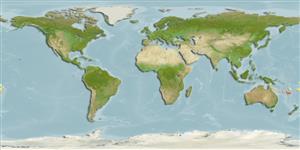>
Syngnathiformes (Pipefishes and seahorses) >
Syngnathidae (Pipefishes and seahorses) > Syngnathinae
Etymology: Hippocampus: Greek, ippos = horse + Greek,kampe = curvature (Ref. 45335); curvicuspis: Name from the Latin 'curvus' for curved and 'cuspis' for spine; referring to the curved spines, including the nape spine and several spines on the superior and lateral trunk ridges.
More on author: Fricke.
Issue
This species is a synonym of Hippocampus hystrix Weber, 1913 according to Lourie et al., 2016 (Ref. 115213). This species record will be removed.
Environment: milieu / Zona climática / intervalo de profundidade / distribution range
Ecologia
marinhas demersal; não migratória; intervalo de profundidade 6 - 20 m (Ref. 86942). Tropical
Distribuição
Países | Áreas da FAO | Ecossistemas | Ocorrências | Mapa de pontos | Introduções | Faunafri
Western Pacific: New Caledonia.
Tamanho / Peso / Idade
Maturidade: Lm ? range ? - ? cm
Max length : 9.8 cm SL (female)
Descrição suscinta
Chaves de identificação | Morfologia | Morfometria
Raios dorsais (total) : 17. This large spiny seahorse is distinguished by the having 17 dorsal fin rays; 17-18 pectoral fin rays; 11 trunk rings; 35-37 tail rings; subdorsal spines 3/0,1,0; moderately large nose spine, height about equal to pupil diameter; double spine above eyes which are moderately long, shorter than eye diameter; single lateral head spine; raised coronet with 4 large spines; restricted gill openings, not close together near the neck ridge; shoulder rings not confluent over neck ridge, not forming continuous collar; the upper shoulder ring spine opposite 11th pectoral fin ray; trunk and tail ridges with many large, curved spines; snout length approximately 57% of head length (Ref. 75989).
Body shape (shape guide): other.
Found in seagrass beds at depths of more than 6 meters (Ref. 75989).
Ciclo de vida ou comportamento de acasalamento
Maturidade | Reprodução | Desova | Ovos | Fecundidade | Larvas
Male carries the eggs in a brood pouch (Ref. 205).
Fricke, R., 2004. Review of the pipefishes and seahorses (Teleostei: Syngnathidae) of New Caledonia, with descriptions of five new species. Stuttgarter Beitr. Naturkd., Ser. A Nr. 668:1-67. (Ref. 75989)
Status na Lista Vermelha da UICN (Ref. 130435: Version 2025-1)
Ameaça para os humanos
Harmless
Uso pelos humanos
Ferramentas
Relatórios especiais
Baixar XML
Fontes da internet
Estimates based on models
Índice de diversidade filogenética (Ref.
82804): PD
50 = 0.5000 [Uniqueness, from 0.5 = low to 2.0 = high].
Bayesian length-weight: a=0.00447 (0.00175 - 0.01142), b=2.99 (2.77 - 3.21), in cm total length, based on LWR estimates for this (Sub)family-body shape (Ref.
93245).
Nível Trófico (Ref.
69278): 3.4 ±0.5 se; based on size and trophs of closest relatives
Resiliência (Ref.
120179): Elevada, tempo mínimo de duplicação da população menor que 15 meses (Preliminary K or Fecundity.).
Fishing Vulnerability (Ref.
59153): Low vulnerability (10 of 100).
🛈
